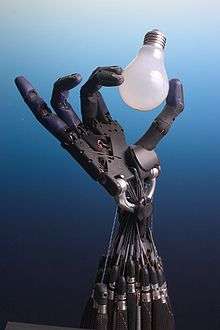Service robot
Service robots assist human beings, typically by performing a job that is dirty, dull, distant, dangerous or repetitive, including household chores. They typically are autonomous and/or operated by a built-in control system, with manual override options. The term "service robot" does not have a strict technical definition. The International Federation of Robotics (IFR) has proposed a tentative definition: "A service robot is a robot which operates semi- or fully autonomously to perform services useful to the well-being of humans and equipment, excluding manufacturing operations."[1]
Types
The possible applications of robots to assist in human chores is widespread. At present there are a few main categories that these robots fall into.
Industrial
Industrial service robots can be used to carry out simple tasks, such as examining welding, as well as more complex, harsh-environment tasks, such as aiding in the dismantling of nuclear power stations. Industrial robots have been defined by the International Federation of Robotics as "an automatically controlled, reprogrammable, multipurpose manipulator programmable in three or more axes, which may be either fixed in place or mobile for use in industrial automation applications".[2]
Domestic

Domestic robots perform tasks that humans regularly perform around their homes such as cleaning floors, mowing the lawn and pool maintenance. People with disabilities, as well as people who are older, may soon be able to use service robots to help them live independently.[3] It is also possible to use robots as assistants or butlers.
Scientific
Robotic systems perform many functions such as repetitive tasks performed in research. These range from the multiple repetitive tasks made by gene samplers and sequencers, to systems which can almost replace the scientist in designing and running experiments, analysing data and even forming hypotheses. The ADAM at the University of Aberystwyth in Wales can "[make] logical assumptions based on information programmed into it about yeast metabolism and the way proteins and genes work in other species. It then set about proving that its predictions were correct."[4]
Autonomous scientific robots perform tasks which humans would find difficult or impossible, from the deep sea to outer space. The Woods Hole Sentry can descend to 4,500 metres and allows a higher payload as it does not need a support ship or the oxygen and other facilities demanded by human piloted vessels.[5] Robots in space include the Mars rovers which could carry out sampling and photography in the harsh environment of the atmosphere on Mars.
Examples of service robots
- AMIGO
- Care-O-bot
- PatrolBot
- CoroBot
- ADAM SGV
- Rollin' Justin
- HelpMate
- Cybermotion
- Roomba
- DESIRE
- Cosero
See also
References
- ↑ Provisional definition of Service Robots English, 27th of October 2012
- ↑ http://www.ifr.org/industrial-robots/
- ↑ Graf, Birgit; Hans, Matthias; Schraft, Rolf D. (2004). "Care-O-bot II—Development of a Next Generation Robotic Home Assistant". Autonomous Robots. Kluwer Academic Publishers. 16 (2): 193–205. doi:10.1023/B:AURO.0000016865.35796.e9. Retrieved 21 October 2015.
- ↑ "Adam becomes first robot to make a scientific discovery after conducting its OWN experiments". Dail Mail. 3 April 2009. Retrieved 31 January 2011.
- ↑ "AUV Sentry". Woods Hole Oceanographic Institution. Retrieved 31 January 2011.
Further reading
- Haidegger T, Barreto M, Goncalves P, Habib MK, Ragavan SKV, Li H et al (2013) Applied ontologies and standards for service robots. Robotics Autonomous Systems 61(11), 1215–1223.
- Sprenger M, Mettler T (2015) Service Robots, Business & Information Systems Engineering, 57(4), 271–274.
